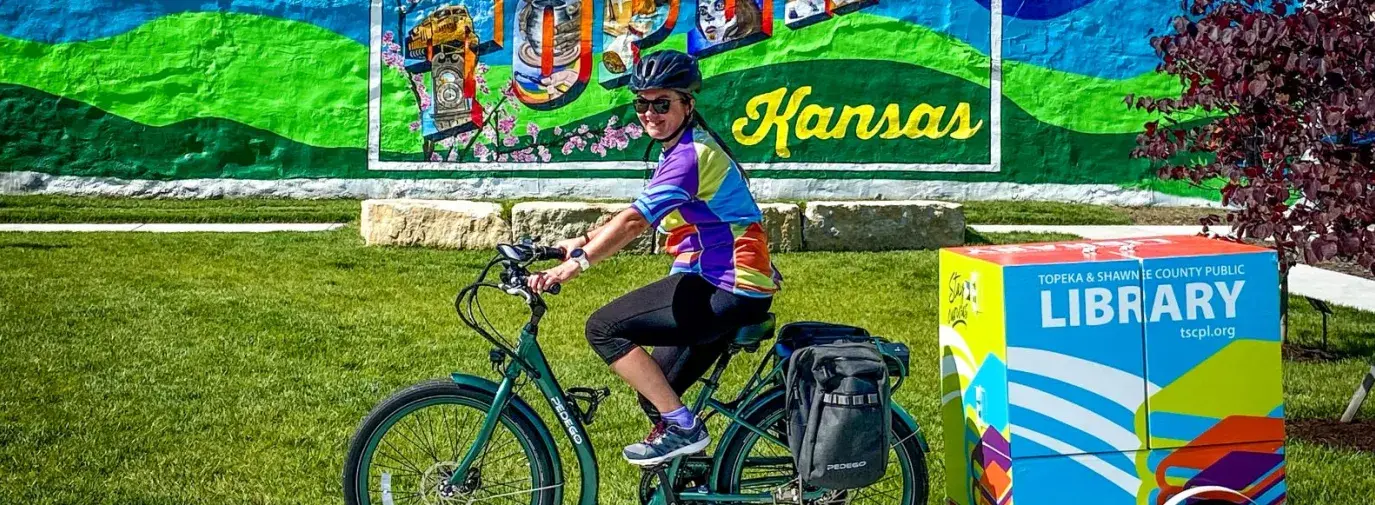
Libraries have always been a place to explore the magic of books, but that’s far from all they do. Around the country, libraries are responding to community-building needs, offering more items and services than just books or a hush—proving what’s good for the Earth is good for people and vice versa.
Get inspired by libraries whose offerings truly green their communities and get ideas on how to bring inclusive items and programming to your local library.
Thinking Outside the Books
“A library is the ultimate recycling organization,” says Diana Friend, communications and marketing director at the Topeka and Shawnee County Public Library (TSCPL) in Kansas. “We have 400,000 items you can borrow, bring back, and share.”
Among those items are some you might not have expected to see at the library of your youth—people can check out luggage for a trip, kits for craft projects, or a health box with a blood pressure machine and scale. TSCPL points patrons to community collaborators for items like tools and seeds, which means that the library and its partners are each able to focus on what they do best.
Another library pushing the envelope with its offerings is Grafton Public Library in central Massachusetts. In the stacks, you’ll find recommended reads, but you might also come across a Barbie cake pan, ukelele, or bocce set.

“Library of Things items allow you to try things that you might not be exposed to otherwise. You can’t know what you like if you don’t know it’s out there. Libraries, in all their offerings, help expose people to new hobbies, interests, and ideas,” says Heidi Fowler, reference librarian. “It’s silly to have to spend the money and then store a pan you’ll use once.”
Grafton’s Library director, Beth Schrieber, says the idea for the Library of Things came from a visit to another library where staff saw a community puzzle swap table and a system that lent out everything that would be needed to experience all the media that the library circulated—like if it lent video games, it also checked out corresponding consoles.
“If you check out a book for your three-year-old and you read it every night as a bedtime story, and they cry when they have to return the book, maybe that’s when you decide you need to own it,” Schrieber says. “But you don’t have to own everything. And that’s the beauty of public libraries—we circulate, and you can borrow whatever you want. The library of things collection just kept growing based on things that might get donated.”
Other items community members share through the library are a home energy assessment kit, a pricey telescope provided in part by an astronomy club, and yard games, for that barbecue.
By stocking items that otherwise might gather dust in a closet, libraries are building interdependent and less wasteful communities. And sustainable services aren’t just limited to things to take home, but experiences, skills, and events.
Thinking Outside the Building
Just as the library is not limited to just books, it’s not limited to what’s inside the building either. Creative services span from TSCPL’s bookmobiles and book bike, which helps the library reach underserved locations, to places to buy and even grow fresh food.
Each Monday in May through September in the TSCPL parking lot, crowds gather at the library’s farmers market. Stalls sell fresh fruits and veggies, along with breads, pickles, and other homemade foods. The farmers market started in 2009 in collaboration with Capital City Wellness and it became even more relevant when the neighborhood’s only grocery store closed in 2016.
“We saw the immediate response of people,” Friend explains. “[The library market] became their only access to fresh vegetables. It’s like in a lot of communities when grocery stores close, and they open up a dollar store—you can get groceries there, but you can’t get fresh.”
In Grafton, produce was grown on-site in connection with demand for a seed library. In seed libraries, patrons check out seeds, plant them, and return some seeds from the crop the following year. Raised beds built in place of the library’s lawn became a popular feature, with Scout troops and volunteers helping staff maintain a sensory garden, pollinator area, and heirloom variety vegetables. During its peak (the program was paused due to the construction of a library expansion), the fruits and vegetables were donated to the food bank and offered in bowls at the front desk for library staff and patrons.
Taking Your Library Past the Pages
“Libraries have never just been about books—we’re in the content business. The Library of Alexandria [in ancient Egypt] circulated scrolls, then it was books. Now we have video games—also valid forms of literature, entertainment, and media,” Schreiber says, herself having published a book called Game On!: Gaming at the Library (under her given name, Beth Gallaway). “But that’s not all people want to check out.”
So, what do you do if you want your library to carry more than the media it does—when you’re looking for a thermal leak detector, shovel and seeds, kayak, or crafting kits? Schreiber mentioned all of these were available at different libraries she’s researched or visited.
First, she recommends talking to your librarian about a swap table, such as for seeds, puzzles, or cake pans—something that the library doesn’t have to take responsibility for and can show if the community has a lot of interest in adding the collection. A further step can be bringing research—articles about a library of things, food security programs, citizenship resources, whatever you want to see—to the staff and board of the library. Every library has a budget; even advocating for $500 to be diverted from one type of content to something new like musical instruments, board games, or gardening tools, can create a shift in culture and a boost in community spirit.
“Start small,” Schrieber recommends. “Talk to the staff first—they might say, ‘That’s cool, let’s try it.’”







